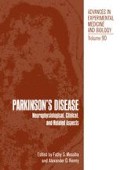Abstract
Rigidity in Parkinson patients can be easily quantitated by determining net work required to passively flex and extend the fore arm through an arc of 100°. Rigidity thus measured can be subdivided into two very distinct types, resting and activated. Resting rigidity, measured while the patient is relaxed, responds to all effective therapeutic agents and correlates closely to degree of clinical improvement. Activated rigidity, measured during voluntary activity, is not relieved by any presently available medical treatment. It remains unchanged at pre-therapy levels even in patients who may temporarily appear to have dramatic improvement in clinical symptomatology. Longitudinal measurements made in hundreds of parkinson patients over intervals ranging from 5 to 15 years show continuing high levels of activated rigidity through the entire period of study.
In marked contrast to our wide experience with parkinson patients is a single, well documented case of Wilson’s disease who appears to have recovered completely both by clinical examination and by all of our machine measurements. This patient had high levels of extrapyramidal deficit, repeatedly measured over a period of four months when penicillamine therapy was being investigated. He then suddenly reverted to normal and returned to full time employment. High values of resting rigidity, activated rigidity, akinesia and resting tremor all reverted to normal and have remained normal for the past 6 years.
The implication of this study is that L-dopa and related treat ments only mask the symptomatology of Parkinson’s disease and are not retarding the underlying pathological process. Penicillamine, on the other hand, probably does relieve the destructive process in Wilson’s disease and may, in early cases, permanently relieve the extrapyramidal dysfunction.
Access this chapter
Tax calculation will be finalised at checkout
Purchases are for personal use only
Preview
Unable to display preview. Download preview PDF.
References
Webster, D.D. (1972). Clinical aspects of rigidity. In Parkinson’s Disease: Rigidity, Akinesia, Behavior (Siegfried, J., Ed.) pp. 66–92, Hans Huber, Bern, Stuttgart, Vienna.
Webster, D.D. (1959). A method of measuring the dynamic characteris tics of muscle rigidity, strength, and tremor in the upper extremity. IRE Trans. on Medical Electronics 6 ,159–164.
Webster, D.D. (1966). Rigidity in extrapyramidal disease. The Second Symposium on Parkinson’s Disease. J. Neurosurg., Suppl. Part II. 299–307.
Webster, D.D. (1968). A critical analysis of disability in Parkinson’s Disease. Mod. Treat. 5 ,257–282.
Sternlieb, I. and Scheinberg, I.H. (1968). Birth Defects Original Article Series, 4 (No. 2), 122–125.
Denny-Brown, D. (1960). Diseases of the basal ganglia. Their relation to disorders of movement. Lancet ii, 1099–1105, 1155–1162.
Rushworth, G. (1961). The gamma system in Parkinsonism. Int. J. Neurol. 2 ,34–50.
Andrews, C.J., Burke, D. and Lance, J.W. (1972). The response to muscle stretch and shortening in Parkinsonian rigidity. Brain 95 ,795–812.
Tatton, W.G. and Lee, R.G. (1975). Evidence for abnormal long-loop reflexes in rigid Parkinsonian patients. Brain Res. 100 ,671–676.
Landau, W.M., Struppler, A., and Mehls, . (1966) O. A comparative electromyographic study of the reactions to passive movement in Parkinsonism and in normal subjects. Neurology (Minneap.) 16 ,34–48.
Cooper, I.S., Riklan, M., Stellar, S., Waltz, J.M., Levita, E., Ribera, V.A., and Zimmerman, J. (1968). A multidisciplinary investigation of neurosurgical rehabilitation in bilateral parkinsonism. J. Amer. Geriat. Soc. 16 ,1177–1306.
Van Buren, J.M., Li, C.L., Shapiro, D.Y., Henderson, W.G., and Sadowsky, D.A. (1973). A qualitative and quantitative evaluation of Parkinsonians three to six years following thalamotomy. Confin. neurol. 35 ,202–235.
Webster, D.D. (1959). A method of measuring the dynamic characteristics of muscle rigidity, strength, and tremor in the upper extremity. IRE Trans, on Medical Electronics 6 ,159–164.
Webster, D.D. (1966). Rigidity in extrapyramidal disease. The Second Symposium on Parkinson’s Disease. J. Neurosurg., Suppl. Part II. 299–307.
Webster, D.D. (1968). A critical analysis of disability in Parkin sons Disease. Mod. Treat. 5 ,257–282.
Webster, D.D. (1969). Dynamic evaluation of thalamotomy in Parkinson’s Disease: Analysis of 75 consecutive cases. In Third Symposium on Parkinson’s Disease (Gillingham, F.J. and Donaldson, I.M.L., Eds) pp. 266–271. E. &S. Livingstone, Ltd., Edinburgh and London.
Webster, D.D. (1972). Clinical aspects of rigidity. In Parkinson’s Disease: Rigidity, Akinesia, Behavior (Siegfried, J., Ed.) pp. 66–92, Hans Huber, Bern, Stuttgart, Vienna.
Author information
Authors and Affiliations
Editor information
Editors and Affiliations
Rights and permissions
Copyright information
© 1977 Plenum Press, New York
About this chapter
Cite this chapter
Webster, D.D., Mortimer, J.A. (1977). Failure of L-Dopa to Relieve Activated Rigidity in Parkinson’s Disease. In: Messiha, F.S., Kenny, A.D. (eds) Parkinson’s Disease. Advances in Experimental Medicine and Biology, vol 90. Springer, New York, NY. https://doi.org/10.1007/978-1-4684-2511-6_21
Download citation
DOI: https://doi.org/10.1007/978-1-4684-2511-6_21
Published:
Publisher Name: Springer, New York, NY
Print ISBN: 978-1-4684-2513-0
Online ISBN: 978-1-4684-2511-6
eBook Packages: Springer Book Archive

